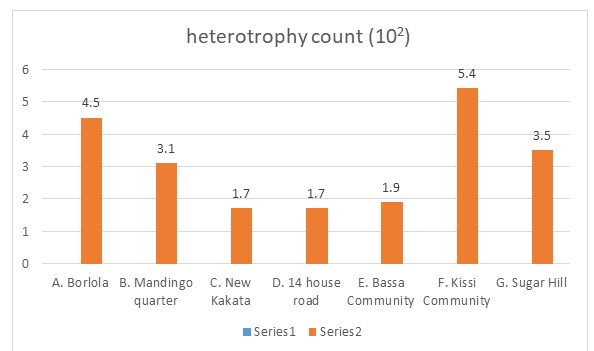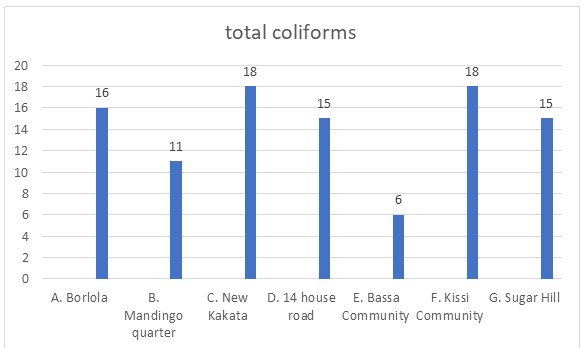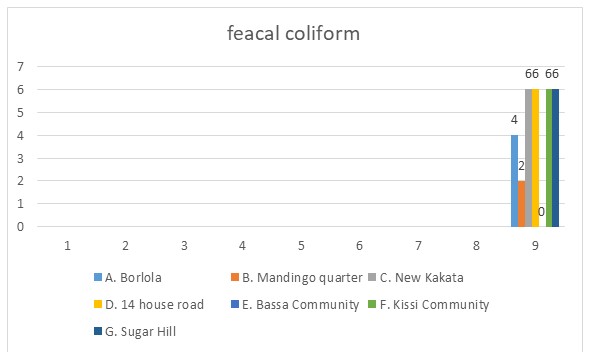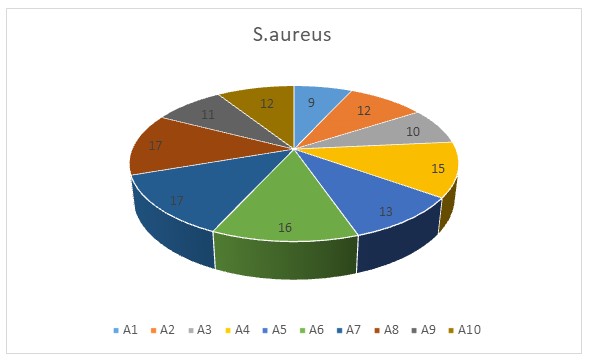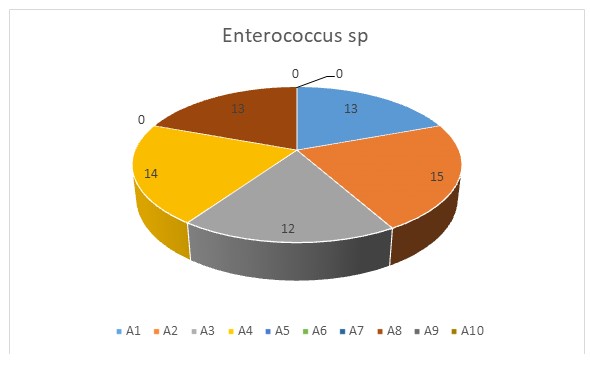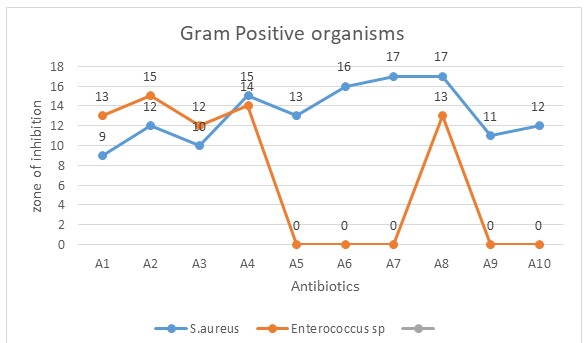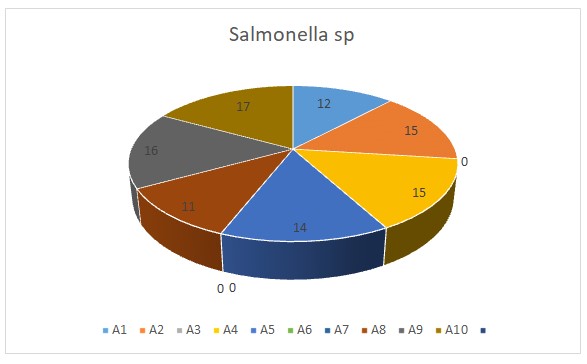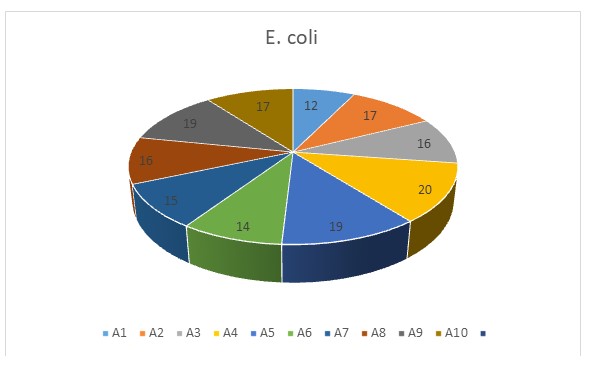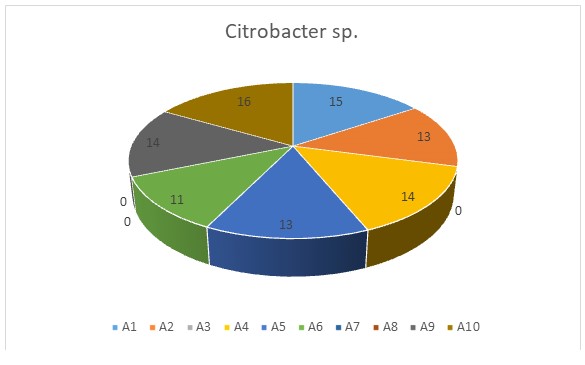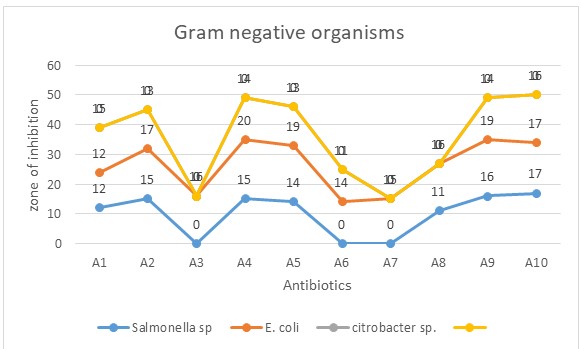Antibiogram of Bacterial Isolated from Selected Borehole Water as source of Drinking Water in kakata, Margibi, Liberia.
- Dr G.I Baysah
- 64-73
- Feb 29, 2024
- Education
Antibiogram of Bacterial Isolated from Selected Borehole Water as Source of Drinking Water in Kakata, Margibi, Liberia.
Dr G.I Baysah
Department of Biology, Adventist University of West Africa,
Margibi County Liberia
DOI: https://doi.org/10.51584/IJRIAS.2024.90208
Received: 18 January 2024; Revised: 27 January 2024; Accepted: 02 February 2024; Published: 29 February 2024
ABSTRACT
Water is acquired from rain, bodies of water (rivers, ponds), and groundwater. Although water can include inappropriate chemicals (from natural sources and agricultural operations), the most serious threat to human wellness is fecal pollution of water supplies, which causes water-borne illnesses. Borehole water samples from seven places in Kakata, Margibi County, Liberia were analyzed for microbial load using standard microbiological procedures. The susceptibility of the microorganisms isolated to commercial antibiotics was also determined. The overall aerobic plate count ranged from 1.9×10 to 5.4×10² cfu/ml, whereas the total coliform count varied from 0.6×10 to 1.8×10 cfu/100ml. The fecal coliform count was low in most samples and entirely absent in one of the research locations. Microbial numbers significantly differed (p=0.05) among the regions investigated. The predominant bacteria isolated were Bacillus species, Enterococcus species, Citrobacter species, Salmonella species, Escherichia coli, and Staphylococcus aureus. The antibiogram performed using the disc diffusion technique revealed that Staphylococcus aureus was most susceptible to streptomycin and least sensitive to ciprofloxacin, while Enterococcus species was most sensitive to septrin but resistant to several of the antibiotics tested. Escherichia coli was the most sensitive to septrin and the least to ciprofloxacin. Ciprofloxacin inhibited Citrobacter species similarly to nalidixic acid. Salmonella species were very vulnerable to nalidixic acid and augmentin, however Bacillus species were resistant to all antibiotics tested, which raises public health concerns.
Keywords: Antibiogram, bacteria, borehole water
INTRODUCTION
Since the civil war ended in 2003, Liberia has struggled to provide safe drinking water. For over 14 years, some Liberian individuals have struggled to acquire clean drinking water, and no assistance has been provided to remedy the problem. In 2008, the World Health Organization reported that inadequate water quality and sanitation cause 18% of all fatalities in Liberia. These infections include diarrhea, malaria, and cholera among others. According to national statistics, just 25% of Liberians have access to safe drinking water and less than one in every five have access to adequate sanitation facilities. However, many Liberians have experienced health problems as a result of the excessive consumption of contaminated drinking water. In many circumstances, individuals are obliged to pay extra on a daily basis to acquire safe drinking water rather than relying on contaminated communal wells. According to a Front Page Africa (FPA) story, an individual complained about the crushing effect of financial expenses required to obtain clean water for laundry.
Chuchu Kordor Selma, WaterAid’s team leader in Liberia, expressed worry about the increasing issue, thinking that the best method to address the issue of clean drinking water in Liberia is to invest appropriately in the government sector. Water Aid, an international charity committed to clean water access, found that fewer than 20% of Liberians have access to hygienic toilets, and over 500 Liberian children die each year from diarrhea caused by filthy circumstances. Furthermore, 3.5 million people in the nation lack access to sufficient sanitation.
Furthermore, WaterAid has been steadily working throughout the last year to produce increased access to clean water and proper sanitary conditions within the country. Due to the organization’s unfailing persistence, more than 12,000 Liberians have been provided with safe water and more than 10,000 have been provided with improved sanitary conditions (Boley 2017).
In addition, WaterAid has been working continuously over the last year to improve access to clean water and sanitary conditions throughout the country. More than 12,000 Liberians have received safe water as a result of the organization’s unwavering commitment, and over 10,000 have received improved sanitary conditions (Boley 2017). Margibi County is located on Liberia’s north-central coast. One of the 15 counties that make up the first level of administrative division in the country. It has five districts. Kakata serves as the county’s seat, with an area of 2.616 square kilometers (1,010 square miles). According to the 2008 Census, it has a population of 199,689, ranking sixth in Liberia.
Kakata District is one of four districts of Margibi County, Liberia. The district includes Kakata, Margibi County’s main city. Margibi County is one of the most recent counties established in 1985 by an interim National Assembly order on December 13, 1985. During the civil war, the county had one of the highest displacement rates. Approximately 200,000 people were relocated in the county between Konala and Kakata. The county was formed by combining the areas of Marshall and Gibi. The county was traditionally inhabited by Bassa tribe. Kpelle, a southwestern Membe speaking people are another tribe who in the region. Water is the medium of life’s processes, and the human body’s daily physiological demand for water is around 3.6 litres. Water accounts for approximately 70% of the human body’s weight and is essential to numerous bodily functions. Aside from the most basic usage of water for drinking, it is necessary for a variety of other activities such as food preparation, laundry, personal and environmental cleanliness. Access to sufficient and high-quality water is a key indicator of community or national development.
Water is harvested from rain, bodies of water (rivers, ponds), or groundwater sources (wells, springs, boreholes). The term ground water has been used to describe subsurface water beneath the water table in soil and geological formations that are fully saturated and can be collected through wells, tunnels, boreholes, or drainage galleries, or which flows naturally to the earth’s surface (WHO 2021). It is an important source of water supply, particularly in areas with lengthy dry seasons that cause stream flow to cease and ponds to dry. Groundwater contributes for approximately 95% of worldwide freshwater supply. It is good for drinking, requires little or no treatment, and is abundantly available, reliable, and often affordable to produce (Kehinde, 1998).
The increasing pollution of surface water by domestic and industrial wastes, combined with the prohibitively expensive construction of water treatment plants and distribution networks for human use, has made ground water an appealing and important option in the social and economic development of numerous communities. Borehole water seldom requires sophisticated treatment. The most frequent treatments are hardness removal and chlorination. Nonchlorinated borehole water contaminated with microorganisms causes a variety of digestive tract illnesses, including paratyphoid fever, cholera, dysentery, shigellosis, and amoebiasis (Itah et al., 1996). Public health officials and engineers use bacteriological test findings to secure public water sources. Good and safe water quality is one of the foundations of sustainable development, and preventing contamination of water sources such as borehole water will ensure the continued existence of humanity. The potability and availability of water for human use and activities should be prioritized. Agencies such as the World Health Organization (WHO), Water Aid, and the United States Environmental Protection Agency have responded to these problems.
Although water can include undesired substances (from natural sources and agricultural operations), the most serious threat to human health is facal pollution of water supplies, which causes water-borne illnesses. The resulting infections are often treated with antibiotics. Antimicrobial resistance among microorganisms is a challenge in treating some infectious illnesses. Drug-resistant strains have been found among staphylococci, gonococci, pneumococci, enterococci (Riboldi et al., 2009), and gram-negative bacteria such as Salmonella, Shigella, Klebsiella, Escherichia coli, Pseudomonas, and Mycobacterium TB (Cheesebrough, 2000).
There has been no scientific study on the antibiogram of bacteria from boreholes in Kakata Margibi Liberia. This study was done to determine the antimicrobial susceptibility pattern of the organisms polluting borehole fluids in Kakata Margibi, Liberia.
MATERIALS AND METHODS:
Sample collection
Twenty-one borehole water samples were obtained for this study. Water samples were collected in sterile 500ml bottles, transferred to the microbiological laboratory, and examined within 6 hours after collection.
MICROBIOLOGICAL ANALYSES:
Laboratory tests were performed to detect the presence of heterotrophic bacteria, total coliforms, and faecal coliforms. The pour plate method was employed using nutritional agar to count heterotrophic bacteria, whereas the membrane filtration technique was utilized to count coliforms and fecal coliforms using membrane lauryl sulphate broth incubated at 37ᵒC and 44ᵒC, respectively. After enumeration, representative colonies were subcultured to yield pure isolates. Pure isolates were characterized using the technique described by Cheesebrough (2000) and John et al. (1994). The sensitivity test was performed using the disc diffusion method (Beathy et al., 2004). Young cultures of bacterial isolates (about 10⁸ cells/ml) were streaked on Mueller-Hinton agar using a sterile swab stick and left to dry for 5 minutes before adding multidisc antibiotics to the culture plates. The antibiotic discs were carefully pressed into the culture using sterile forceps to ensure contact. After applying the discs, the plates were incubated at 37ᵒC for 18 hours. Zones of inhibition measured in millimeters in diameter. The antibiotic discs utilized included ciprofloxacin (10μg), streptomycin (30μg), peflacine (10μg), septrin (30μg), ampicillin (30μg), tarivid (10μg), ceporex (10μg), gentamycin (10μg), augumentin (30μg), and nalidixic acid (30μg).
Statistical analysis
The microbiological determination data were statistically examined using the ANOVA technique. The means were separated using Fisher’s least significant difference (LSD), as reported by Sanders (1990).
RESULTS
Figure1: Microbial load of the borehole water samples for heterotrophy
Figure 2: Microbial load of the borehole water samples for the total coliforms
Figure 3: Microbial load of the borehole water samples for the feacal coliforms
Table 1: Total Microbial Load of the Borehole Water Samples
| Sample | Total heterotrophic | Total Coliform | Total feacal Coliform |
| Location | Count (cfu/ml) | Count *cfu/100ml) | Count (Cfu/100ml) |
| A. Borlola | 4.5×10² | 16 | 4 |
| B. Mandingo quarter | 3.1×10² | 11 | 2 |
| C. New Kakata | 1.7×10² | 18 | 6 |
| D. 14 house road | 1.7×10² | 15 | 6 |
| E. Bassa Community | 1.9×10² | 6 | 0 |
| F. Kissi Community | 5.4×10² | 18 | 6 |
| G. Sugar Hill | 3.5×10² | 15 | 6 |
Figure 4: the zone of inhibition of S. aureus against the antibiotics
Figure 2: the zone of inhibition of Enterococcus sp. around the antibiotics
Figure 6: the zone of inhibition for test microbes against selected antibiotics
Table 2: Antibiotic Sensitivity of Gram positive Isolates
| Antibiotic | Concentration | Zone of inhibition | (mm diameter) | |
| S. aureus | Enterococcus sp | Bacillus sp | ||
| Ciprofloxacin | 10μg | 9 | 13 | – |
| Norfloxacin | 10μg | 12 | 15 | – |
| Gentamycin | 10μg | 10 | 12 | – |
| Lincocin | 20μg | 15 | 14 | – |
| Streptomycin | 30μg | 13 | – | – |
| Rifampicin | 20μg | 16 | – | – |
| Erythromycin | 30μg | 17 | – | – |
| Cloramphenicol | 30μg | 17 | 13 | – |
| Ampiclox | 20μg | 11 | – | – |
| Floxapen | 20μg | 12 | – | – |
Disc size = 8mm
– = no zone of inhibition
Figure 7: the zone of inhibition of Salmonella sp. around the antibiotics
Figure 8: the zone of inhibition of E. coli around the antibiotics
Figure 9: the zone of inhibition of Citrobacter sp. around the antibiotics
Figure 10: the zone of inhibition of microbes. around the antibiotics
Table 3: Antibiotic Sensitivity of Gram negative Isolates
| Antibiotic | Concentration | Zone of Inhibition | (mm diameter | |
| Salmonella sp | E. Coli | Citrobacter sp | ||
| Augumentin | 30μg | 16 | 19 | 14 |
| Streptomycin | 30μg | 15 | 17 | 13 |
| Tarivid | 10μg | – | 14 | – |
| Septrin | 30μg | 15 | 20 | 14 |
| Ampicillin | 30μg | 14 | 19 | 13 |
| Peflacine | 10μg | – | 16 | 11 |
| Ceporex | 10μg | – | 15 | – |
| Gentamycin | 10μg | 11 | 16 | – |
| Ciprofloxacin | 10μg | 12 | 12 | 15 |
| Nalidixic acid | 30μg | 17 | 17 | 16 |
Disc size = 8mm
– = no zone of inhibition
DISCUSSION
Table 1 displays the findings of the mean counts of heterotrophic bacteria shown in figure 1, total coliforms displayed in figure 2, and fecal coliforms shown in figure 3 of borehole water samples from the various study locations. The organisms’ mean numbers varied from 1.9×10 to 5.4 x10²cfu/ml, 0.6×10 to 1.8×10 cfu/100ml, and 0 to 6 cfu/100ml. The levels exceeded the acceptable standard for these species (WHO, 1984). However, comparable high microorganism loads have been recorded in borehole and well water from other regions of Africa (Agbu et al., 1996).
The microbial loads also varied considerably among sites (p=0.05). The lack of consistency in borehole construction and treatment in the Kakata city likely contributed to this issue. Some boreholes were drilled near septic tank absorption fields. Leakage of dirty water from septic tanks can lead to borehole pollution. Tanks and reservoirs used to store borehole water before use, on the other hand, might be potential sources of pollution. Although many of the samples were chlorinated, several still contained coliforms, which might be attributable to a variety of factors. It has been reported that coliforms can be found in both chlorinated and non-chlorinated water, and that their complete eradication from water would necessitate knowledge of their population in such water as well as determining the amount of chlorine required for complete destruction, in addition to providing functional chlorinators (Clark et al., 1982).
Tables 2 and 3 illustrate the in-vitro antibiotic sensitivity patterns of the bacterial isolates. All of the antibiotics tested inhibited Staphylococcus species and Escherichia coli. Salmonella sp. was sensitive to nalidixic acid but resistant to peflacine, tarivid, and ceporex. Citrobacter followed the same pattern as Salmonella, but was resistant to genatamycin. Antibiotic resistance was observed in Enterococcus species isolated from food, consistent with previous studies (Riboldi et al., 2009). Bacillus sp. was resistant to every antibiotic tested. This differs with the reported 100% sensitivity of Bacillus sp. to erythromycin and chloramphenicol (Umar et al., 2006). The sensitivity and resistance of isolates to antibiotics varied depending on their concentration, source, and drug resistance transfer (Tables 2 and 3; Shewmake & Dillon, 1998). It has also been noted that organisms can develop various antibiotic resistances.
In conclusion, the investigation showed that borehole water in Kakata city does not meet WHO recommended drinking water criteria. Adequate treatment is recommended before to use, and any cases of waterborne disease or food poisoning caused by the use of these polluted waters may be treated with sensitive antibiotics such as Norflaxacin, Ciprofloxacin, Lucosin, and Chlorophenicol.
REFERENCES
- Agbde, I.O.; Adegoye, M.S. (2003) Assessment of the quality of bore-hole water in Benue State, Nigeria J. agric Sci. technol. 13:39-52.
- Asare K.O., (2004). Hydrogen Reduction of Metal Ions: An Electrochemical Model, Hydrometal. Proc. Int. Symp. (2): 1151–1165.
- Agbu, A.A.; Alaribe, H.C.; singh; Adesiyun, A.A. (1988). Bacteriological studies and chemical analysis of public well water in samara and Zaria city in Northern Nigeria. Nig. J. Microbiol. 8:88-98.
- Bauer, A.W.; Kirby, W.M.M.; Sherris, J.C.; Turek, M. (1966). Antibiotic susceptibility testing by Standardized single Disc method. Am. J. Clin. Pathol., 45:493-496.
- Beathy, M.E.; Cheryl, A.B.; well, J.G.; Kathy, D.G.; Puhr, N.D.; Mintz, E.D. (2004). Enterotoxin Escherichia coli 0169:441, United States. Emerging Inf. Dis. 10(3):518-521.
- Boehm AB, Graham KE, Jennings WC. Can we swim yet? (2018) Systematic review, meta-analysis, and risk assessment of aging sewage in surface waters. Environ Sci Technol. 52:9634–9645.
- Cheesbrough, M.(2000). District Laboratory Pactice in Tropical Countries. Part 2. Cambridge University Press, U.K.
- Clark, J.A.; Burger, G.A.; Satationes, L.E. (1982). Characterization of indicator bacteria in Municipal raw water, drinking water and new main water Suppliess. J. gen. Microbiol. 55: 1002-1013.
- Itah,A.T.; Etukudo, s.m.; Akpan, E.J. (1996). Bacteriological and chemical analysis of some rural Water supplies in Calabar, Nigeria. West Afr. J. Biol. Appl. Chem. 41:1-10.
- John, G.H.; Neol, R.K.; Peter, H.A.; James, T.S.; Stanley, T.W. (1994). Bergey’s Manual of Detyerminative Bacteriology (9 edition), Williams and Wickins, Maryland.
- Karen Levy, Kara L. Nelson, Alan Hubbard, and Joseph N.S. Eisenberg4 (2008). Following the Water: A Controlled Study of Drinking Water Storage in Northern Coastal Ecuador. Environ Health Perspect 116:1533–1540.
- Kapoor V, Gupta I, Pasha ABMT, Phan D. (2018) Real-time quantitative PCR measurements of fecal indicator bacteria and human-associated source tracking markers in a Texas river following Hurricane Harvey. Environ Sci Technol Lett. 5:322–328.
- Kehinde, O.M.; (1998). The impact of industrial growth on ground water quality and availability: a Case study of Ikeja industrial area in: Comminuque and Proceedings of Workshop Jointly Organized by the Federal Environmental Protection Agency and the Federal ministry of Budget and Planning, Abuja. FEPA, Lagos; Pp25-35.
- Korajkic A, Wanjugi P, Brooks L, Cao Y, Harwood VJ. (2019) Persistence and decay of fecal microbiota in aquatic habitats. Microbiol Mol Biol Rev. pp. 83.
- Maraj S., Rodda N., Jackson S., Buckley C. and Macleod N. (2006). Microbial deterioration of stored water for users supplied by stand-pipes and ground-tanks in a peri-urban community. Water SA Vol. 32 No.
- McLellan SL., Sauer EP., Corsi SR., Bootsma MJ., Boehm AB., Spencer SK. (2018) Sewage loading and microbial risk in urban waters of the Great Lakes. Elem Sci Anth. 6:46.
- Murphy H.M., Sampsonb M., McBeana E., Farahbakhsh K., (2010). Influence of household practices on the performance of clay pot water filters in rural Cambodia. Desalination 252: pp145–152.
- Otiang’a E.O. and Oswe I.A. (2007). Human impact on lake ecosystems: the case of Lake Naivasha, Kenya. African Journal of Aquatic Science. 32 (1): 79-88
- Riboldi, G.P.; frazzon, J.; d’Azevedo, P.A.; A.P.G. (2009). Antimicobial resistance profile of Enterococcus spp. Isolated from food in Southern Brazil. Braz. J. Microbiol 40: 125-128.
- Shewmake, R.A.; Dillon, B. (1998). Food Poisoning: Causes, remedies and prevention. The Practical Peer – review Journal for primary Health care Physician 103 (6):10.
- Stewart JR, Boehm AB, Dubinsky EA, Fong T-T, Goodwin KD, Griffith JF. (2013) Recommendations following a multi-laboratory comparison of microbial source tracking methods. Water Res. 47:6829–6838.
- Sulaiman G.M. Lawen S.E. Shelear H.H., (2011). Effect of storage temperature and sunlight exposure on the physicochemical properties of bottled water in Kurdistan region-Iraq J. Appl. Sci. Environ. Manage. Vol. 15 (1) 147 – 154
- Umar, A.F.; tahir, F.; Yarima, M.B. (2006). Antimicrobial sensitivities of Bacillus cereus isolates in Food solid in Bauchi Metropolis to some selected antibiotic. Nig. J. Microbiol. 20(3): 1460 – 1464.
- WHO (2021) Guidelines for Drinking Water Quality, Drinking Water quality control in small Community supplies. WHO, Geneva, Switzerland 3:121-130.
- WHO (2009). World Health Organization handbook on indoor radon: A public health perspective. Geneva, World Health Organization.

